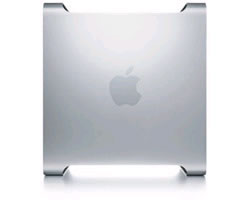Apple Power Mac G5


On Monday, at the keynote speech of the Worldwide Developers' Conference in San Francisco, Steve Jobs ruefully acknowledged the leak, saying: 'I am here today to tell you: it was a mistake...and it's true'. With that, Jobs unveiled the Power Mac G5. Aside from being Apple's first major chip upgrade since the G4 debuted (at 400MHz) in 1999, the G5 marks some major changes for Apple. First of all, the chip itself is IBM's 64-bit PowerPC 970 -- making this the first time since 1984 that Apple hasn't used a Motorola-manufactured processor. In addition, the G5 is the first 64-bit chip to be used in a desktop computer, according to Jobs, promising that standard 32-bit applications will run natively on the new platform. Whether anyone but graphics professionals will need a 64-bit chip and its possible maximum of 8GB of memory remains to be seen. The G5 also bumps the Mac processor speed from a maximum of 1.2GHz to 2GHz, and Apple promises a 3GHz G5 within a year. In addition, many Apple watchers have speculated that a move to IBM-based chips could lead to cheaper systems. The new machines, available in August, are priced at £1,549, £1,849 and £2,299 (inc. VAT).
New architecture: built for speed
Since it connects the chip itself to the motherboard and the main memory modules, the system bus (also known as the frontside bus) is widely considered to affect computer performance as much as, if not more than, processor speed. The top-of-the-line G5 features a whopping 1GHz system bus, while the low-end and midrange models feature 800MHz and 900MHz system buses, respectively. Apple is making an especially large system bus jump in the G5 line -- the current G4 series system bus is just 167MHz. The G5 also uses faster 400MHz DDR memory, as opposed to the G4's 333MHz DDR SDRAM.
The entry-level G5 comes with a 1.6GHz processor, 256MB of memory, an 800MHz system bus, an 80GB hard drive and an Nvidia GeForce FX 5200 graphics card. The mid-range system holds a 1.8GHz G5 processor, a 900MHz system bus, 512MB of memory, a 160GB hard drive and the GeForce FX 5200 graphics card. The high-end model offers dual 2GHz G5 chips, 512MB of memory, a 160GB hard drive and an ATI Radeon 9600 graphics card. All three machines come with Apple's new 4X CD-RW/DVD-R (SuperDrive).
Updates--inside and out
All three models have a new look, too. The new Power Mac's design is sleek, metallic and very squared-off, compared to the rounded look of the G4 series. From afar, the G5 looks suspiciously like a standard, beige-box PC, distinguished only by handles and, of course, the big grey apple on the side. Up close, it's somewhat squat, silver (it's encased in aluminium), and super-slick. Both the front and the back of the machine are covered with breathable mesh aluminium; the front features a perfectly flat optical-drive opening that actually retracts from top to bottom, rather than opening inward or outward. On the inside, Apple is using nine fans to cool this powerhouse's innards, but the company says that each fan runs independently, creating a machine two to three times quieter than the jet-engine-like G4.
As for connectivity, Apple finally gets into the USB 2.0 groove -- both the front and the back panel sport USB 2.0 slots. You'll get a FireWire 400 port on the front panel, along with a headphone jack; the back features another FireWire 400 port, as well as a FireWire 800 port. The high-end and mid-range models offer three full-size PCI-X slots (one 133MHz, 64-bit and two 100MHz, 64-bit openings). Multimedia lovers can appreciate the optical-digital audio in, optical-digital audio out, analogue audio in, and analogue audio out, in addition to a headphone mini-jack on the front side. No models include a standard AirPort Extreme card or built-in Bluetooth, but both are options.
The G5 ships with OS X 10.2 Jaguar -- soon to be Panther -- as well as the iLife digital-media suite, iCal, iSync, Mail and Apple's usual assortment of third-party software.